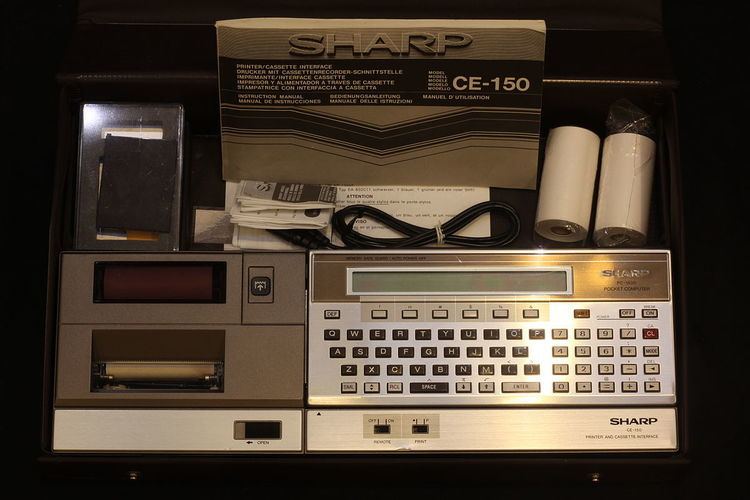 | ||
The Sharp PC-1500 was a pocket computer produced by Sharp during 1981-1985. A rebadged version was also sold as the TRS-80 Pocket Computer PC-2.
Contents
- Technical specifications
- Accessories
- Related Sharp pocket computers
- BASIC compatibility with early models
- Example program in BASIC
- Usage of variables
- Display of the answers are as follows
- Programm description
- References
The whole computer was designed around the LH5801, an 8-bit CPU similar to the Zilog Z80, but all laid-out in power-saving CMOS circuits. Equipped with 2KB of on-board RAM, the programming language is BASIC. Later German engineers provided an assembler for the machine. Later even a C compiler followed. An external slot is available and accept memory (from 4 KB to 32 KB) and rom modules.
Eight versions of this pocket computer with 2 KB memory:
Two versions with 8 KB memory:
Technical specifications
Accessories
Related Sharp pocket computers
BASIC compatibility with early models
Some earlier model PC-1500s will show a value 1 less in the FOR...NEXT counter on exiting the loop compared to later PC-1500s and the PC-1600.
For example:
10 FOR K=1 TO 10
20 NEXT K
30 PRINT K
K will be set to 11 on later model PC-1500s and PC-1600s, but will be 10 on early PC-1500s.
Consider this example:
10 S=0
20 FOR K=1 TO 10 STEP 4
30 S=S+1
40 NEXT K
50 PRINT S
S will be set to 3 on later model PC-1500s and PC-1600s, but will be 4 on early PC-1500s.
Early model PC-1500s evaluate IF...THEN statements differently. The behaviour can be summarised thus:
An early model PC-1500 can be detected by using the command: PEEK&C5C0.
If the value returned is 6, it is an early model.
Example program in BASIC
1 ARUN 10 5 REM "PC1500 VAT Program:"10 INPUT "Price: ";P20 PRINT P;" ";V*R;" ";P*V*M 30 GOTO 1040 ENDThe PC-1500 allows special abbreviations, and the syntax can also look as follows:
20 PRINT P;" ";PV;" ";PVMUsage of variables
P = Purchase Price
V = VAT (%/100) - To be input by hand before calculation begins, e.g.: V=1.14 (Enter)
M = Markup (%/100) - To be input by hand before calculation begins, e.g.: M=1.15 (Enter)
Display of the answers are as follows
Answer1; Answer2; Answer3
Purchase Price; VAT Price; Sales Price
Value: P; Value: P*V; Value: P*V*M
Programm description
Line 1 The ARUN command executes every time the computer is switched on and jumps to line 10.
Line 5 This is the REMARK statement (used to include remarks into the source code).
Line 10 The INPUT command asks for input from the user and stores the values in the variable "P".
Line 20 The PRINT command shows the calculated result as follows: 100 114 142.5. The abbreviated form is a special for the PC-1500, as it can only make use of single letter variables and matrixes. This also saves valuable storage space!
Line 30 The GOTO command lets the programme jump back to line 10, to continue the program over
Line 40 The END statement is to be placed on the last line of the code to terminate execution, however in this cas it can be omitted, as it is not really necessary.
